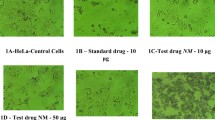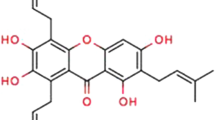Abstract
Cervical cancer is one of the grave uterine tumors which leads to death in women worldwide. Troxerutin (TRX) as a bioflavonoid compound has many pharmacological effects such as anti-neoplastic, radioprotective, and anti-cancer. The present study was designed to examine the cytotoxic effect of TRX on human HeLa tumor cells. Human HeLa cells were cultured and treated with different doses of TRX (20–640 mg/ml) to evaluate the effective half-maximal inhibitory concentration (IC50) after 24 h. MTT (3-(4,5-dimethylthiazol-2-yl)-2,5-diphenyltetrazolium bromide) test was used for cell proliferation assay. Also, the Bax, Bcl-2, cleaved caspase-3, and tumor necrosis factor-α (TNF-α) protein expression levels were detected with immunoblotting analysis. The malondialdehyde (MDA) concentration, glutathione peroxidase (GPx) and superoxide dismutase (SOD) activity levels were measured via their commercial kits. Data were analyzed using one-way ANOVA. The result showed that TRX at 320 mg/ml concentration (IC50) has a growth inhibitory effect against HeLa cells at 24 h treatment (P ˂ 0.01). Moreover, it increased the MDA concentration and also decreased the GPx and SOD activity levels at 320 mg/ml concentration versus control (P < 0.001). Also, TRX significantly up-regulated the Bax, cleaved caspase-3 and TNF-α proteins expression levels (P < 0.01) and down-regulated the Bcl-2 protein expression in HeLa tumor cells at 320 mg/ml concentration compared to control (P < 0.05). Our study showed that 24 h of treatment with TRX (320 mg/ml) has apoptotic and growth inhibitory effects against HeLa cells. It can induce inflammation (at least via up-regulating the TNF-α protein expression) and oxidative stress in human HeLa cells.





Similar content being viewed by others
Data availability
All data are inserted in the manuscript.
References
Zhu H, Luo H, Zhang W, Shen Z, Hu X, Zhu X (2016) Molecular mechanisms of cisplatin resistance in cervical cancer. Drug Des Devel Ther 10:1885–1895. https://doi.org/10.2147/dddt.s106412
van Meerten E, Franckena M, Wiemer E, van Doorn L, Kraan J, Westermann A, Sleijfer S (2015) Phase I study of cisplatin, hyperthermia, and lapatinib in patients with recurrent carcinoma of the uterine cervix in a previously irradiated area. Oncologist 20(3):241–242. https://doi.org/10.1634/theoncologist.2014-0365
Ordikhani F, Erdem Arslan M, Marcelo R, Sahin I, Grigsby P, Schwarz JK, Azab AK (2016) Drug delivery approaches for the treatment of cervical cancer. Pharmaceutics 8(3):23. https://doi.org/10.3390/pharmaceutics8030023
Hou T, Zhang W, Tong C, Kazobinka G, Huang X, Huang Y, Zhang Y (2015) Putative stem cell markers in cervical squamous cell carcinoma are correlated with poor clinical outcome. BMC Cancer 15:785. https://doi.org/10.1186/s12885-015-1826-4
Lopez J, Poitevin A, Mendoza-Martinez V, Perez-Plasencia C, Garcia-Carranca A (2012) Cancer-initiating cells derived from established cervical cell lines exhibit stem-cell markers and increased radioresistance. BMC Cancer 12:48. https://doi.org/10.1186/1471-2407-12-48
Hodgkinson N, Kruger CA, Mokwena M, Abrahamse H (2017) Cervical cancer cells (HeLa) response to photodynamic therapy using a zinc phthalocyanine photosensitizer. J Photochem Photobiol B Biol 177:32–38. https://doi.org/10.1016/j.jphotobiol.2017.10.004
Hiyama E (2014) Pediatric hepatoblastoma: diagnosis and treatment. Transl Pediatr 3(4):293
Florea AM, Busselberg D (2011) Cisplatin as an anti-tumor drug: cellular mechanisms of activity, drug resistance and induced side effects. Cancers 3(1):1351–1371. https://doi.org/10.3390/cancers3011351
Sivaraj R, Rahman PK, Rajiv P, Narendhran S, Venckatesh R (2014) Biosynthesis and characterization of Acalypha indica mediated copper oxide nanoparticles and evaluation of its antimicrobial and anticancer activity. Spectrochim Acta Part A Mol Biomol Spectrosc 129:255–258. https://doi.org/10.1016/j.saa.2014.03.027
Costa-Lotufo LV, Khan MT, Ather A, Wilke DV, Jimenez PC, Pessoa C, de Moraes ME, de Moraes MO (2005) Studies of the anticancer potential of plants used in Bangladeshi folk medicine. J Ethnopharmacol 99(1):21–30. https://doi.org/10.1016/j.jep.2005.01.041
Elliott M, Chithan K (2017) The impact of plant flavonoids on mammalian biology: implications for immunity, inflammation and cancer. The flavonoids advances in research since 1986. Routledge, Abingdon, pp 619–652
Kaeidi A, Sahamsizadeh A, Allahtavakoli M, Fatemi I, Rahmani M, Hakimizadeh E, Hassanshahi J (2020) The effect of oleuropein on unilateral ureteral obstruction induced-kidney injury in rats: the role of oxidative stress, inflammation and apoptosis. Mol Biol Rep 47(2):1371–1379. https://doi.org/10.1007/s11033-019-05237-0
Ren W, Qiao Z, Wang H, Zhu L, Zhang L (2003) Flavonoids: promising anticancer agents. Med Res Rev 23(4):519–534
Yang X, Wang F, Hu S (2006) The electrochemical oxidation of troxerutin and its sensitive determination in pharmaceutical dosage forms at PVP modified carbon paste electrode. Colloids Surf B Biointerfaces 52(1):8–13. https://doi.org/10.1016/j.colsurfb.2006.05.020
Kaeidi A, Taghipour Z, Allahtavakoli M, Fatemi I, Hakimizadeh E, Hassanshahi J (2020) Ameliorating effect of troxerutin in unilateral ureteral obstruction induced renal oxidative stress, inflammation, and apoptosis in male rats. Naunyn Schmiedebergs Arch Pharmacol 393(5):879–888. https://doi.org/10.1007/s00210-019-01801-4
Thomas NS, George K, Selvam AAA (2019) Anticancer mechanism of troxerutin via targeting Nrf2 and NF-κB signalling pathways in hepatocarcinoma cell line. Toxicol In Vitro 54:317–329
Maurya DK, Salvi VP, Krishnan Nair CK (2004) Radioprotection of normal tissues in tumor-bearing mice by troxerutin. J Radiat Res 45(2):221–228. https://doi.org/10.1269/jrr.45.221
Panat NA, Singh BG, Maurya DK, Sandur SK, Ghaskadbi SS (2016) Troxerutin, a natural flavonoid binds to DNA minor groove and enhances cancer cell killing in response to radiation. Chem Biol Interact 251:34–44. https://doi.org/10.1016/j.cbi.2016.03.024
Subastri A, Suyavaran A, Preedia Babu E, Nithyananthan S, Barathidasan R, Thirunavukkarasu C (2018) Troxerutin with copper generates oxidative stress in cancer cells: its possible chemotherapeutic mechanism against hepatocellular carcinoma. J Cell Physiol 233(3):1775–1790. https://doi.org/10.1002/jcp.26061
Hajializadeh Z, Nasri S, Kaeidi A, Sheibani V, Rasoulian B, Esmaeili-Mahani S (2014) Inhibitory effect of Thymus caramanicus Jalas on hyperglycemia-induced apoptosis in in vitro and in vivo models of diabetic neuropathic pain. J Ethnopharmacol 153(3):596–603
Rasoulian B, Kaeidi A (2017) Cellular preoxygenation partially attenuates the antitumoral effect of cisplatin despite highly protective effects on renal epithelial cells. Oxid Med Cell Longev 2017:7203758. https://doi.org/10.1155/2017/7203758
Kaeidi A, Hajializadeh Z (2019) Leptin attenuates oxidative stress and neuronal apoptosis in hyperglycemic condition. Fundam Clin Pharmacol 33(1):75–83. https://doi.org/10.1111/fcp.12411
Souza AO, Pereira LC, Oliveira DP, Dorta DJ (2013) BDE-99 congener induces cell death by apoptosis of human hepatoblastoma cell line - HepG2. Toxicology In Vitro Int J Pub Assoc BIBRA 27(2):580–587. https://doi.org/10.1016/j.tiv.2012.09.022
Hseu YC, Lee MS, Wu CR, Cho HJ, Lin KY, Lai GH, Wang SY, Kuo YH, Kumar KJ, Yang HL (2012) The chalcone flavokawain B induces G2/M cell-cycle arrest and apoptosis in human oral carcinoma HSC-3 cells through the intracellular ROS generation and downregulation of the Akt/p38 MAPK signaling pathway. J Agric Food Chem 60(9):2385–2397. https://doi.org/10.1021/jf205053r
Kausch I, Böhle A (2002) Antisense oligonucleotide therapy in urology. J Urol 168(1):239–247
Thomas NS, George K, Selvam AAA (2019) Anticancer mechanism of troxerutin via targeting Nrf2 and NF-kappaB signalling pathways in hepatocarcinoma cell line. Toxicol In Vitro Int J Pub Assoc BIBRA 54:317–329. https://doi.org/10.1016/j.tiv.2018.10.018
Li Y, Wang SJ, Xia W, Rahman K, Zhang Y, Peng H, Zhang H, Qin LP (2014) Effects of tatariside G isolated from Fagopyrum tataricum roots on apoptosis in human cervical cancer HeLa cells. Molecules 19(8):11145–11159. https://doi.org/10.3390/molecules190811145
Chen Q, Li P, Li P, Xu Y, Li Y, Tang B (2015) Isoquercitrin inhibits the progression of pancreatic cancer in vivo and in vitro by regulating opioid receptors and the mitogen-activated protein kinase signalling pathway. Oncol Rep 33(2):840–848. https://doi.org/10.3892/or.2014.3626
Dong Y, Wu Y (2017) Lysophosphatidic acid triggers apoptosis in HeLa Cells through the upregulation of tumor necrosis factor receptor superfamily member 21. Mediators Inflamm 2017:12. https://doi.org/10.1155/2017/2754756
Lee K, Lee MH, Kang YW, Rhee KJ, Kim TU, Kim YS (2012) Parkin induces apoptotic cell death in TNF-alpha-treated cervical cancer cells. BMB Rep 45(9):526–531. https://doi.org/10.5483/bmbrep.2012.45.9.104
Zhao Q, Wang W, Cui J (2019) Melatonin enhances TNF-alpha-mediated cervical cancer HeLa cells death via suppressing CaMKII/Parkin/mitophagy axis. Cancer Cell Int 19:58. https://doi.org/10.1186/s12935-019-0777-2
Sidoti-de Fraisse C, Rincheval V, Risler Y, Mignotte B, Vayssiere JL (1998) TNF-alpha activates at least two apoptotic signaling cascades. Oncogene 17(13):1639–1651. https://doi.org/10.1038/sj.onc.1202094
Singh K, Poteryakhina A, Zheltukhin A, Bhatelia K, Prajapati P, Sripada L, Tomar D, Singh R, Singh AK, Chumakov PM (2015) NLRX1 acts as tumor suppressor by regulating TNF-α induced apoptosis and metabolism in cancer cells. Biochim et Biophys Acta (BBA)-Mol Cell Res 1853(5):1073–1086
Shi RX, Ong CN, Shen HM (2004) Luteolin sensitizes tumor necrosis factor-alpha-induced apoptosis in human tumor cells. Oncogene 23(46):7712–7721. https://doi.org/10.1038/sj.onc.1208046
Wajant H, Pfizenmaier K, Scheurich P (2003) Tumor necrosis factor signaling. Cell Death Differ 10(1):45
Nogueira V, Hay N (2013) Molecular pathways: reactive oxygen species homeostasis in cancer cells and implications for cancer therapy. Clin Cancer Res Off J Am Assoc Cancer Res 19(16):4309–4314. https://doi.org/10.1158/1078-0432.ccr-12-1424
Sullivan LB, Chandel NS (2014) Mitochondrial reactive oxygen species and cancer. Cancer Metab 2(1):17
Liu H, Jiang C, Xiong C, Ruan J (2012) DEDC, a new flavonoid induces apoptosis via a ROS-dependent mechanism in human neuroblastoma SH-SY5Y cells. Toxicol In Vitro Int J Pub Assoc BIBRA 26(1):16–23. https://doi.org/10.1016/j.tiv.2011.10.002
Acknowledgements
This study was supported by Rafsanjan University of Medical Sciences (Grant No. 98267).
Author information
Authors and Affiliations
Contributions
Conceived and designed the experiments: AK, JH, ZH. Performed the experiments: AK, JH, AM and ZH. Analyzed the data: AK and ZH. Contributed reagents/materials/analysis tools: AK and JH. Wrote the paper: JH, AM, AK and ZH.
Corresponding author
Ethics declarations
Conflict of interest
The authors declare that there are no conflicts of interest.
Ethical approval
All ethical considerations of the Journal have been approved.
Informed consent
All authors agree to submit the manuscript to this journal. All authors are content with their participation in the study.
Additional information
Publisher's Note
Springer Nature remains neutral with regard to jurisdictional claims in published maps and institutional affiliations.
Rights and permissions
About this article
Cite this article
Hassanshahi, J., Mirzahosseini-pourranjbar, A., Hajializadeh, Z. et al. Anticancer and cytotoxic effects of troxerutin on HeLa cell line: an in-vitro model of cervical cancer. Mol Biol Rep 47, 6135–6142 (2020). https://doi.org/10.1007/s11033-020-05694-y
Received:
Accepted:
Published:
Issue Date:
DOI: https://doi.org/10.1007/s11033-020-05694-y




